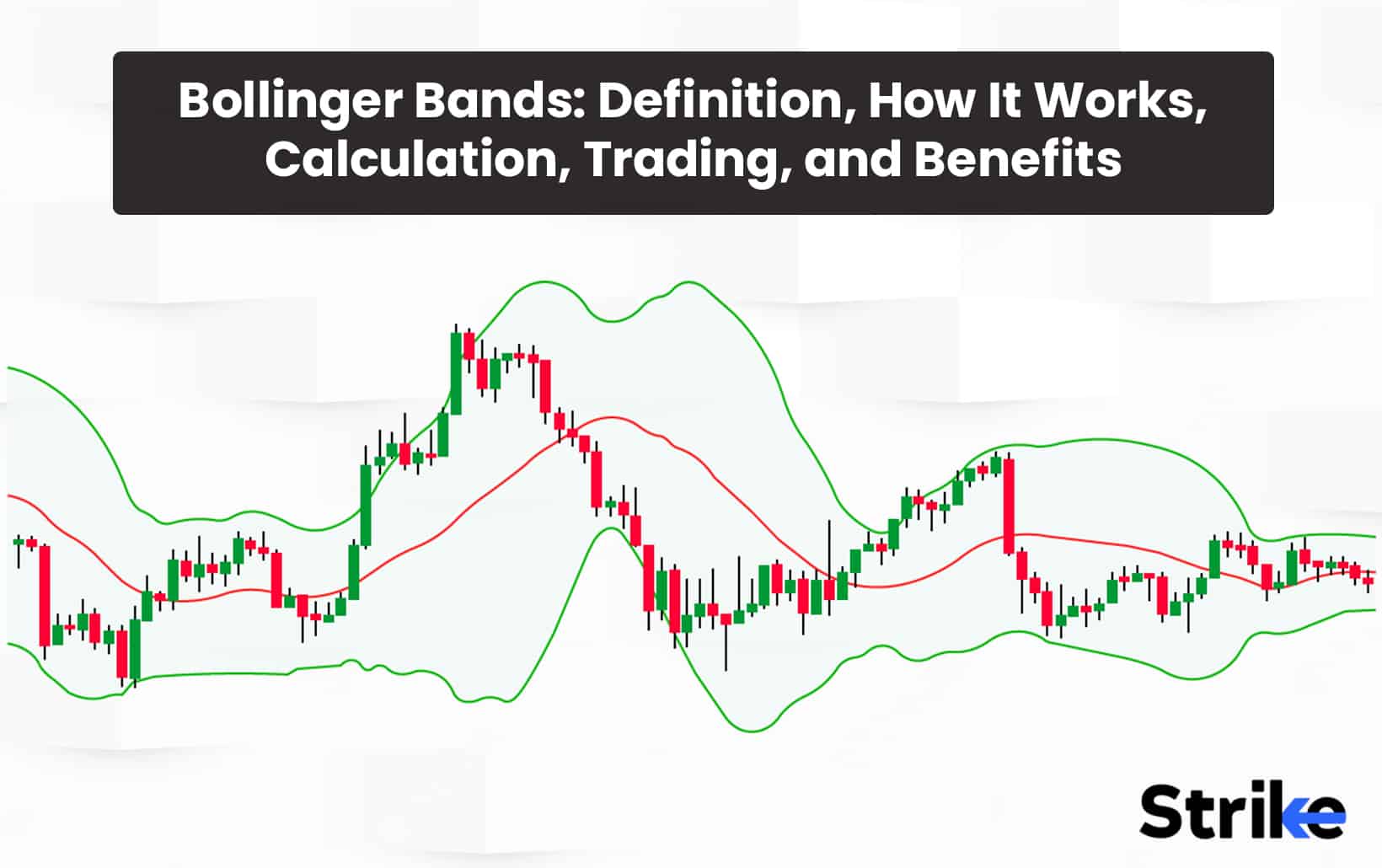
Bollinger Bands are a type of statistical chart that characterises the prices and volatility of a financial instrument over a period of time using a formula. Bollinger Bands formula was developed by technical trader John Bollinger in the 1980s. These charts are used by financial traders in the process of decision-making. Bollinger Bands are also an important component of technical analysis. Bollinger Bands are a type of price envelope which defines the upper and lower price range levels.
An important benefit of Bollinger bands is that they help determine whether prices are high or low on a relative basis. They help the investors by providing the necessary information on the probability of identifying if an asset is oversold or overbought. Bollinger Bands plot two bands around a moving average – an upper bollinger band and a lower bollinger band. The bollinger bands calculation uses standard deviation to set the width of the bands.
Wider bollinger bands indicate higher volatility while closer bands indicate lower volatility. Bollinger band indicators help traders make decisions about overbought and oversold conditions. When price touches the upper bollinger band, it may be overbought and ready for a pullback. When price touches the lower band, it may be oversold and ready for a bounce.
See this video below for a detailed explanation on Bollinger Bands.
What is the Bollinger Band?
Bollinger Bands are a type of price envelope. An envelope is a technical tool that consists of two parallel lines, which are usually plotted above and below a moving average or another reference line. The distance between the upper and lower lines is typically a fixed percentage or a specific number of points. Bollinger Bands are envelopes plotted at a standard deviation level above and below a simple moving average of the price. The distance of the bands is based on the standard deviation, and they adjust to volatility swings in the underlying price.
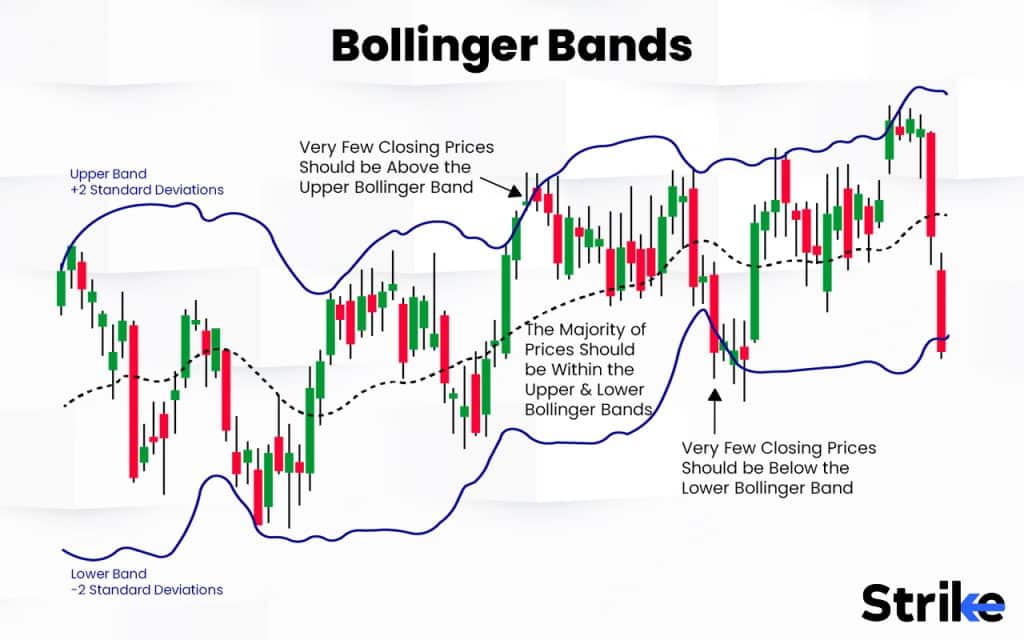
Bollinger Bands display a graphical band and volatility in a two-dimensional chart. It is represented by three different lines which are drawn with one below and one above the security price line. Its specific period moving average is denoted as the midline to form an envelope. These lines show a band or a volatility range in which a particular security’s price is moving up or down. Volatility is shown on the basis of the standard deviation for a particular security.
This is denoted by the upper and lower lines or bands as the standard deviation is a measure of volatility. The distance of the bands is based on the standard deviation, and they adjust to the volatility swings in the underlying price. The Standard deviation changes when volatility increases and decreases. The bands automatically widen when volatility increases and contract when volatility decreases. Their dynamic nature allows them to be used on different securities with standard settings. The image uploaded below shows how Bollinger Bands looks when it is applied on a chart.
What is the origin of Bollinger Bands?
Bollinger Band was developed by John Bollinger who worked as Financial News Network’s Chief Technical Analyst in the mid-80s. Bollinger Band is an envelope in the form of two lines which surround the price bars on a chart.
Bollinger Bands are a tool used by traders and investors to understand market volatility. There were other efforts to capture market volatility before John Bollinger proposed his idea. Wilfrid Ledoux used the monthly highs and lows of the Dow Jones Industrial Average to predict long-term market movement in 1960. The history of trading bands got lost in time after that until it was proposed later by Hurst. Many others tried to construct similar trade bands inspired by Hurst but achieved little success. Percentage bands became popular in the 70s.
It was easy to use and was a simple moving average graph that showed the highs and lows, which were plotted against a user-specified percentage. The modern Bollinger Bands are developed on the idea of Donchian Bands, which are price envelope bands showing the highest and lowest price differences for a particular number of days. Donchian Bands are, however, only taken into consideration for the recent highs and lows, which gives Bollinger Bands a clear advantage over them. It uses standard deviation, which makes it dynamic and adaptive to the market.
John Bollinger founded Bollinger Capital Management, which is a firm specialising in providing technical analysis and investment advice to investors. The idea for Bollinger Bands was inspired by J. Welles Wilder Jr., who had introduced the concept of using standard deviation to measure volatility. J. Welles Wilder Jr. worked on volatility indicators and the concept of using the standard deviation to measure price volatility. Wilder introduced the concepts of the Average True Range (ATR) and the Relative Strength Index (RSI), which became widely used technical indicators. Bollinger further developed this concept into his own indicator by using the standard deviation as a measure of volatility.
Bollinger Bands were first introduced to the public in the 1980s. They gained widespread recognition and popularity due to their ability to identify potential price breakouts and reversals.
John Bollinger published his findings on Bollinger Bands in his book titled “Bollinger on Bollinger Bands,” which was released in 2001. The book acts as a guide for investors in order to understand and effectively utilise the Bollinger Bands in various market scenarios.
John Bollinger continues to be an influential figure in the field of technical analysis. He is a frequent speaker at financial conferences and has significantly contributed to the understanding and application of technical analysis concepts. Bollinger Bands have also become a widely recognised and utilised technical analysis tool.
How does the Bollinger Bands indicator work in Technical Analysis?
Bollinger bands are an important component of technical analysis and a popular form of technical price indicator. Bollinger Bands are made up of an upper, lower, and middle band which is a moving average. The upper and lower bands are set on either side of a Simple Moving Average (SMA). Each of the bands is plotted two standard deviations away from the Simple Moving Average (SMA) of the market, and they are capable of highlighting the areas of support and resistance. An area of resistance is encountered when the price approaches the upper band, and an area of support is encountered when the price approaches the lower band.
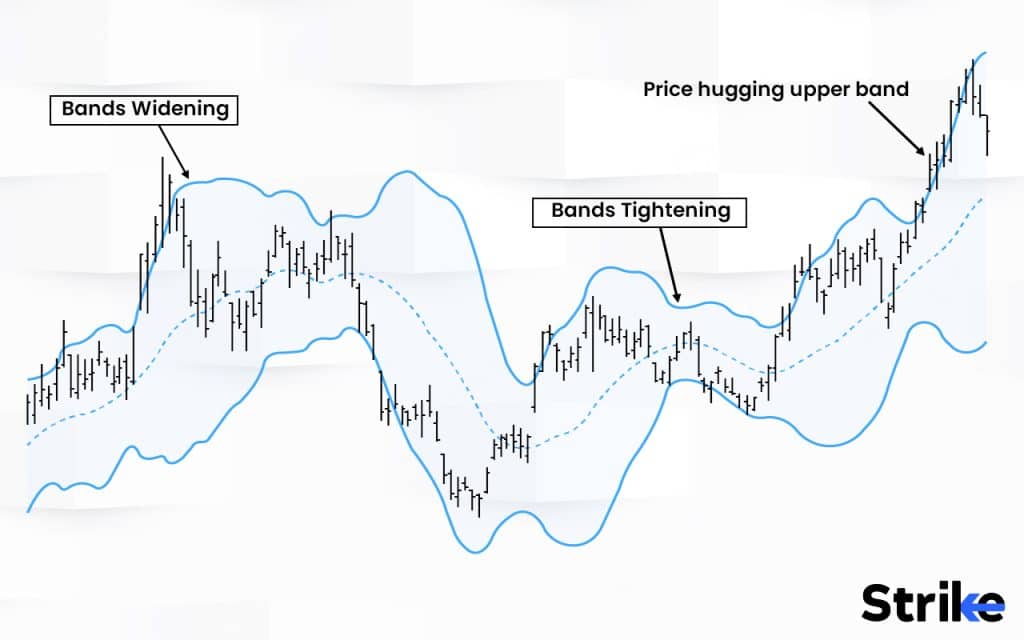
Bollinger Bands also incorporate volatility. The general principle in technical analysis is that a trader can determine the price of the stock, that is if it is relatively low or relatively high by comparing a stock’s position relative to the bands. The width of the band is also an indicator of its volatility in technical analysis. Narrow bands indicate less volatility, and wider bands indicate higher volatility.
In the image uploaded below, you can observe how the price has reacted from the bollinger bands components represented in the black box. The price reacts from the SMA in the middle and bounces from upper and lower bands.
The upper, lower, and middle bands create a price envelope. These bands are dynamic, which allows them to be used for different asset classes to understand price fluctuations and determine overall trends. The overall trends can be determined through technical analysis of the price. An upward trend is indicated when the price is constantly trading above the middle band, and a downward trend is indicated when the price is constantly trading below the middle band. Bollinger Bands are considered a technical analysis tool that helps traders evaluate price action and a stock’s volatility.
What is the importance of the Bollinger Bands indicator?
Bollinger Bands are a popular technical analysis tool used by traders and investors. Bollinger Bands are one of many indicators that are simple to understand and easy to interpret. It acts as a comprehensive guide for investors and traders to use it profitably.
Another important feature of Bollinger bands is that they use standard deviation which is dynamic, and it also adjusts to market volatility. The band grows wider during volatile market periods and narrows during less volatile periods. Traders measure the width of the band in order to measure volatility. The current market price of stock also helps traders and investors in the decision-making process. An overbought market is indicated when the current market price of a stock is close to its upper Bollinger band while an oversold market is indicated when the current market price of a stock is close to its lower Bollinger band.
The main objective of the Bollinger Bands indicator is to give the terms high and low a relative definition. Prices are relatively high at the Upper Bollinger Band and relatively low at the Lower Bollinger Band. Bollinger Bands can also identify potential trend reversals and breakouts. A Bullish breakout is indicated when the price breaks above the upper band, while a bearish breakout is indicated when the price breaks below the lower band. The movement of the price from one band to another signals a potential trend reversal in the market price of the stock.
What is the Bollinger Bands formula?
The Bollinger Band consists of 3 lines. They are the upper band, lower band and the middle band.
Here is the formula for the 3 lines.
Middle Band = 20 day simple moving average (SMA)
Upper Band = 20 day SMA + (20-day standard deviation of price x 2)
Lower Band = 20 day SMA – (20-day standard deviation of price x 2)
How to calculate Bollinger Bands?
Traders use the formulas to calculate the three bands.
The formula for Standard deviation:

Standard deviation (SD) is the square root of the summation of the numbers in the population minus the mean divided by sample size. The next step after calculating the Standard deviation is calculating the upper and lower Bollinger bands. The Bollinger upper and lower bands are calculated by multiplying SD by two and both adding and subtracting the number from the value to plot upper and lower values.
The Bollinger Upper band is calculated by adding the 20-day simple moving average with the 20-day standard deviation multiplied by 2. Here is the formula for calculating the Bollinger Upper band:
BOLU=MA(TP,n)+m∗σ[TP,n]
The Bollinger Lower Band is calculated by subtracting the 20-day simple moving average from the 20-day standard deviation multiplied by 2. Here is the formula for calculating the Bollinger lower band:
BOLD=MA(TP,n)−m∗σ[TP,n]
Where,
BLOU = Bollinger Upper Band
BOLD = Bollinger Lower Band
MA = Moving Average
TP= Typical Price (High+Low+Close) / 3
N = Number of days in Moving Average (typically 20)
M = Number of SD (typically 2)
σ[TP,n] = SD over last n periods of TP
Most of the trading platforms calculate Bollinger bands automatically but it is still useful for traders and investors to understand and learn them.
What do Upper Bollinger Bands represent in Technical Analysis?
Upper Bollinger Bands in technical analysis help the traders with decision-making and they also act as a guide while investing in the stock market. Upper Bollinger Bands help traders predict if a stock is overbought. Overbuying is indicated when the stock price moves closer to the upper band. Traders consider this a signal to adjust their positions, as there could be a potential pullback.
The purpose of Bollinger Bands is also to provide a relative definition of the high and low prices of a market. Upper Bollinger Bands indicate that the current market price of a stock is high, and traders usually buy when the price breaks above the upper Bollinger Band.
The upper Bollinger bands can also identify potential trend breakouts and reversals. A bullish breakout is indicated when the price breaks above the upper band in technical analysis. The movement of the price from one band to another band signals a potential trend reversal in the market price of the stock.
In the image uploaded below, the purple box represents potential trend reversal after touching the upper bollinger band twice. And after taking sufficient support from the lower band, the price managed to break and cross the upper band indicating a trend continuation towards upside.
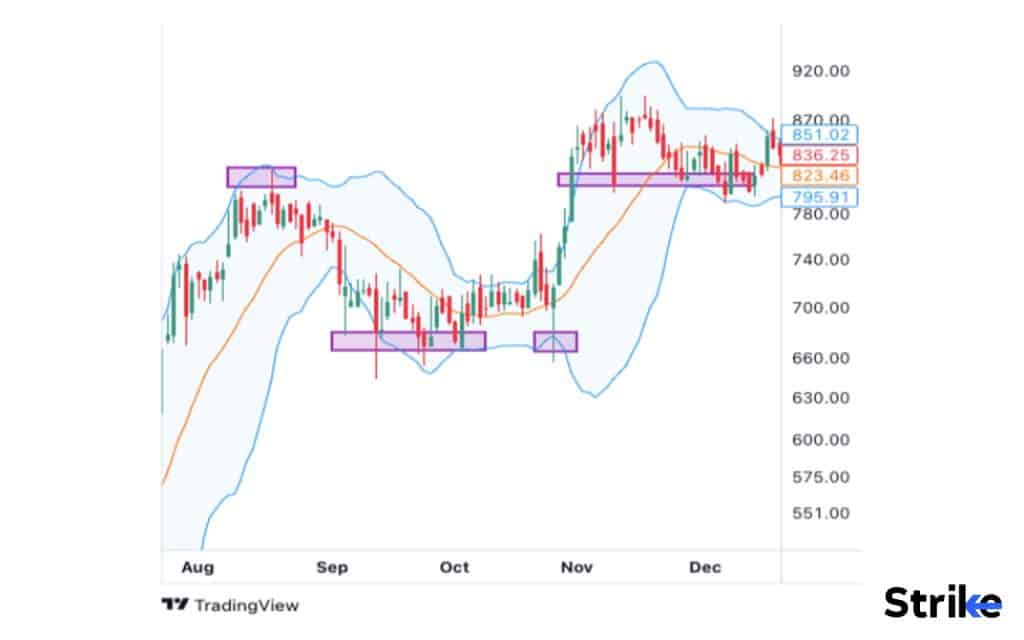
The upper Bollinger bands are capable of highlighting areas resistance. An area of resistance is encountered when the price approaches the upper band in technical analysis. Traders can monitor them to decide whether the price will reverse or break through resistance levels.
Upper Bollinger Bands in technical analysis are used with other indicators in order to confirm trading signals and take important decisions.
What do Lower Bollinger Bands indicate in Technical Analysis?
Lower Bollinger Bands in technical analysis help traders with decision-making and they also act as a guide while investing in the stock market. Lower Bollinger Bands help traders predict if a stock is oversold. An oversold condition is indicated when the stock price moves closer to the lower band. Traders consider this a signal to adjust their positions, as there could be a potential consolidation. There is a rapid decline in the market price of the stock, and traders usually start buying at this point.
The purpose of Bollinger Bands is also to provide a relative definition of the high and low prices of a market. Lower Bollinger Bands indicate that the current market price of a stock is low and traders usually buy and expect the price to increase.
The lower Bollinger bands can also identify potential trend breakouts and reversals. A bearish breakout is indicated when the price breaks below the lower band in technical analysis. The movement of the price from one band to another signals a potential trend reversal in the market price of the stock.
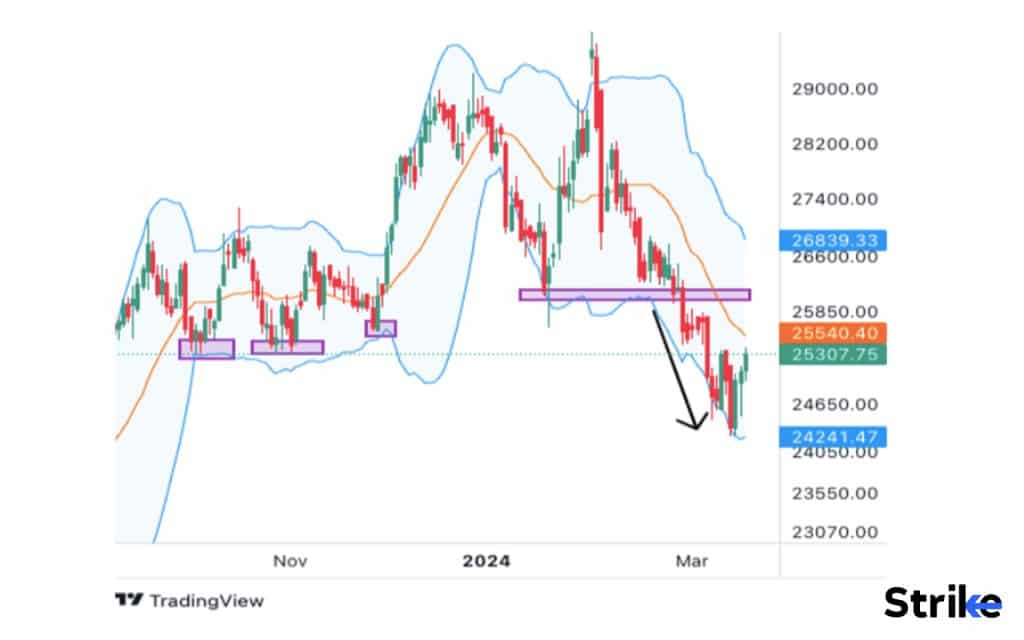
In the image uploaded above, the first few purple boxes represent how the lower bollinger band managed to act as a strong support and the price of the stock bounced from that level. The arrow represents the breakdown of the lower band indicating trend shiftment towards downside.
The lower Bollinger bands are capable of highlighting areas of support. An area of support is encountered when the price approaches the lower band in technical analysis. Traders can monitor them to decide whether the price will reverse or break through support levels.
The lower Bollinger Bands in technical analysis is used with other indicators in order to confirm trading signals and take important decisions. The signals provided by the lower Bollinger band also help in successful trading.
How to use Bollinger bands in Trading?
Bollinger Bands are a technical analysis tool for the purpose of trading stocks. The dynamic nature of the Bollinger Bands are applied on the chart to procure additional confirmation about the trend of the stock or any security. Here are the different ways to use Bollinger bands in trading.
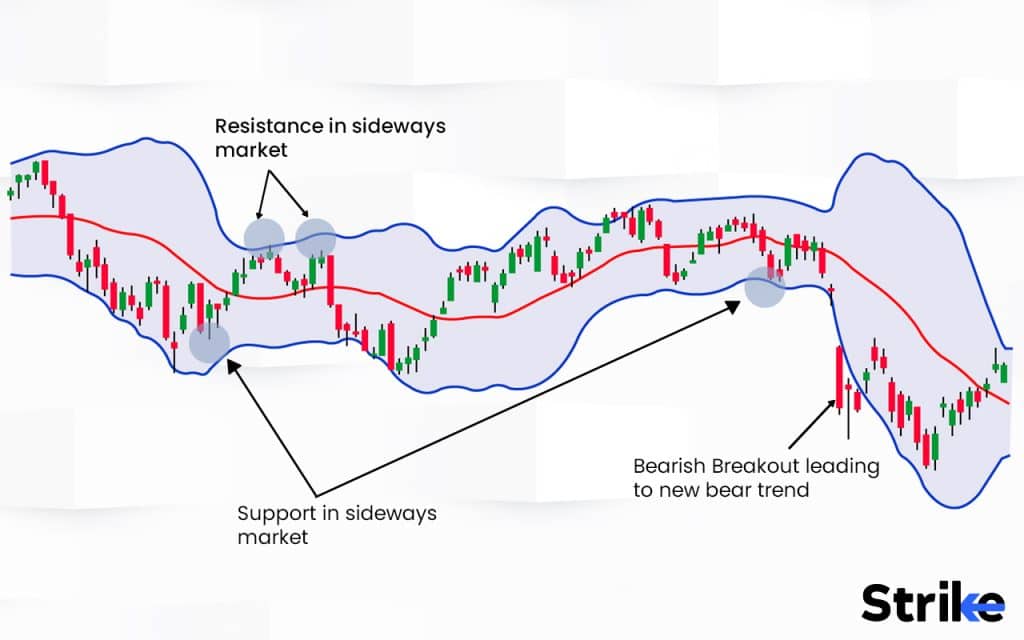
- Indicator of volatility: The bands comprise a volatility indicator that measures the relative high or low of a security’s price in relation to previous trades. Volatility is measured using the standard deviation, which changes with an increase or decrease in volatility. Standard deviation points are plotted against it to represent price fluctuations. The Bollinger band widens when there is a price increase and grows during volatile market periods. The Bollinger band narrows when there is a price decrease and also gets narrower during less volatile periods. Traders measure the width of the band in order to measure volatility.
Strike.money is one of a kind scanner that scans all the stocks based on the bollinger bands giving either the widening signal (indicating increasing volatility) and narrowing signal (indicating decreasing volatility). In the image below, Strike.money has sorted and presented the list of stocks that are indicating Widening signal (upcoming volatility) The scanner enables users to sort the list based on hourly, daily, weekly and monthly time frames.
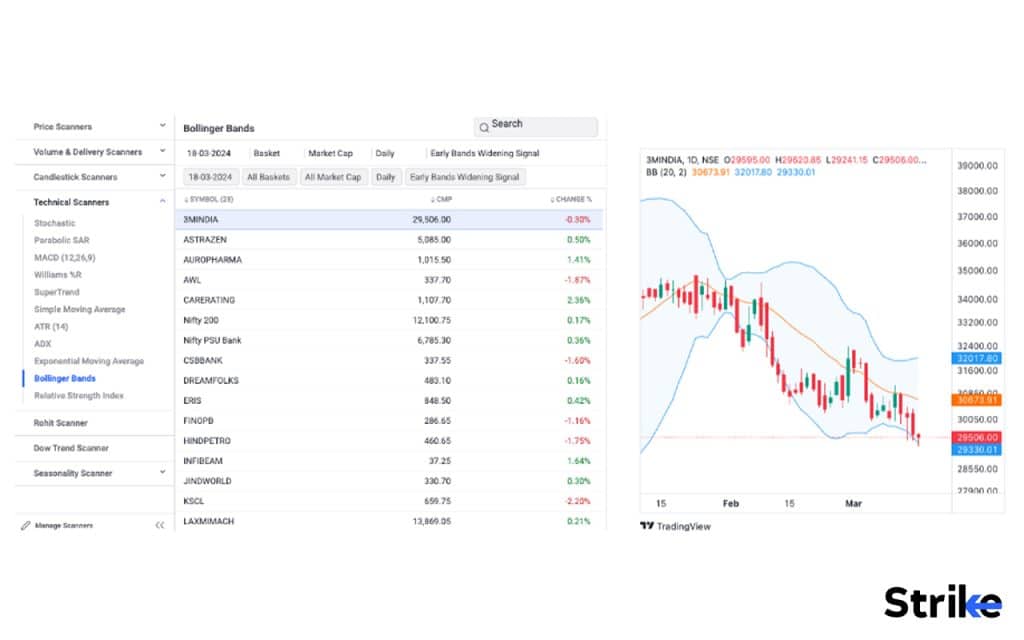
In the image below, these drop down menus provide the following scanners.

- Overbought and oversold Strategy: Overbought and oversold is a common strategy used by traders with Bollinger bands. This strategy is used to identify overbought and oversold regions in the current market conditions. The current market price of stock also helps the traders and investors in the decision-making process. An overbought market is indicated when the current market price of a stock is close to its upper Bollinger band while an oversold market is indicated when the current market price of a stock is close to its lower Bollinger band. The trader buys expecting the price to return back to the middle band in an oversold market, and the trader sells expecting the price to return back to the middle band in an overbought market. This strategy is not preferred in strong-trending markets.
- Bollinger Bands Squeeze/tightening Strategy: This is another strategy used by traders while trading with Bollinger Bands. A squeeze is formed when the price moves sideways in the consolidation. The upper and lower Bollinger Bands come close to each other when the price moves in consolidation. This means that the volatility of the stock has decreased. This is not always the case and the volatility of the stock will tend to increase again after a certain period of time. The price makes a large move in either direction after the consolidation. The increase in volume on a breakout signals that the stock is no longer in consolidation and is going to form an upward or downward trend. The trader can buy or sell accordingly when the price breaks the upper or lower band.
Strike.money’s scanner has sorted the list of stocks which are undergoing a squeeze in the bollinger bands. This way, a trader’s time for stock selection is saved. Customization of the basket is made in such a way that the list presents only the stocks present in F&O and Only indices.
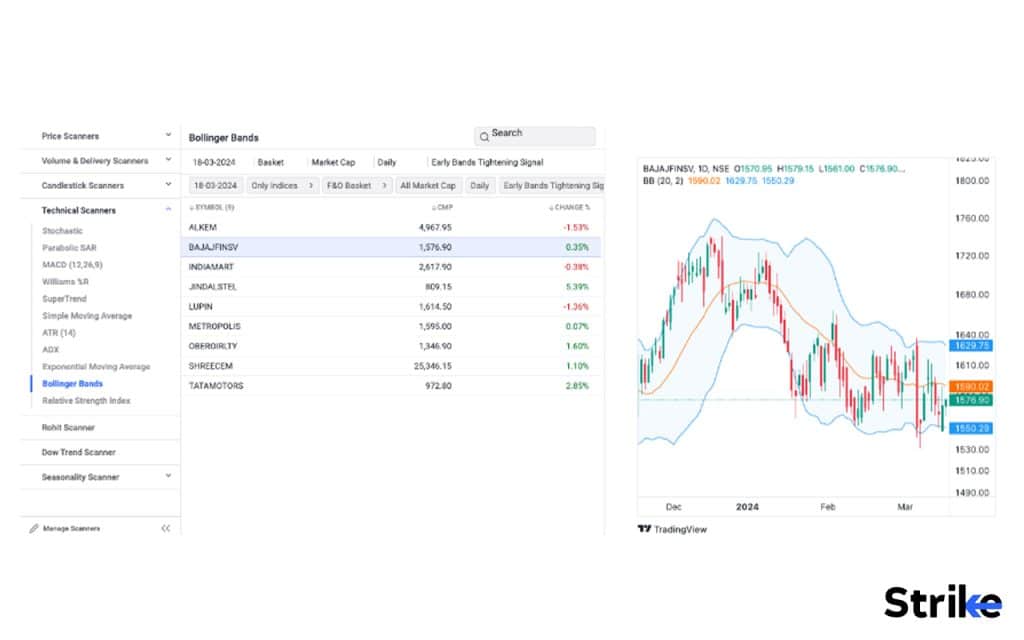
- Potential Trend breakouts and reversals: The Bollinger Bands can also identify potential trend breakouts and reversals. A bullish breakout is indicated when the price breaks above the upper band, while a bearish breakout is indicated when the price breaks below the lower band in technical analysis. The movement of the price from one band to another signals a potential trend reversal in the market price of the stock. Traders consider the bullish breakout a buying opportunity and the bearish breakout a selling opportunity.
Strike.money in its bollinger bands scanner provides a list of stock based on, if the price of the script is reversing from the upper or lower bollinger band. This way, the reversal stocks can be scanned and the trader’s valuable time of selection of stocks is reduced, helping him/her to focus on further analysis of the selected stocks. In the image below, an option of ‘Price crossing above the lower band’ is selected; meaning; all the stocks under the F & O section are displayed which are showing signs of reversing and closing above the lower band indicating a trend reversal towards the middle line or the upper band.
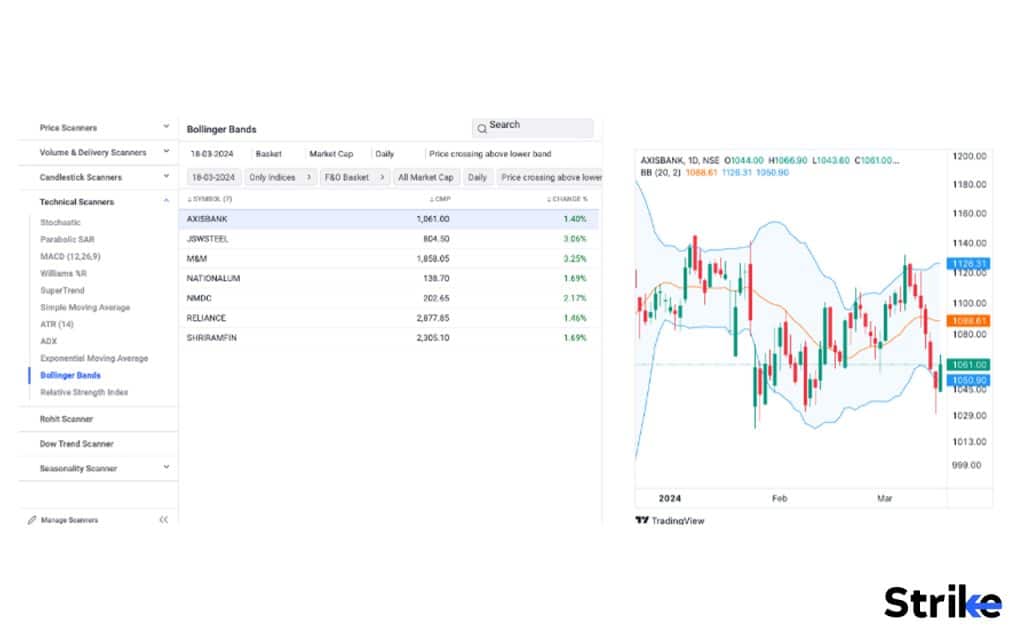
The drop down menus offer; ‘Price crossing below the upper band’, displaying the list of stocks that are reversing from the upper band and has potential to travel till the middle or the lower band.
- Support and resistance levels: The Bollinger Bands are capable of highlighting areas of support and resistance. An area of resistance is assumed when the price approaches the upper band in technical analysis, while an area of support is assumed when the price approaches the lower band in technical analysis.
The middle line of the bollinger band is also very useful. Short term traders can find potential trading opportunities when the price reacts from the middle line to travel either towards the upper band or the lower band.
This way, bollinger bands are an important analytical tool. Though no indicator works thoroughly, bollinger bands have various functions a trader can take advantage of. Like already discussed; to measure volatility, potential trend reversal or continuation trades.
Traders can monitor them to decide whether the price will reverse or break through support and resistance levels.
Bollinger Bands are an important tool in technical analysis. They are also widely used by traders and investors to measure market volatility, identify potential trading opportunities, and determine key support and resistance levels.
How can Bollinger Bands determine trade entry and exit points?
Bollinger bands determine trade entry and exit points in multiple ways. As the lower and upper bollinger band provide a price point of potential support or resistance area; if in case of a price reacting from the lower bollinger band with evidence of demand, traders can place entries around the demand price and place a stop order a few points below the band. Vice versa for the short position around the upper bollinger bands and placing a safe stop loss a few points above the upper band to ride a short trade.
An existing long position can be exited when the price keeps approaching the upper bollinger bands indicating potential overbought conditions. Vice versa in case of price approaching lower bollinger bands.
It is important to note that the price may break above the bands signalling wrong trades as well.
The middle SMA is also used by traders to enter in short term trades on lower time frames.
This way, bollinger bands can be used to enter fresh trades, place stop loss exit orders and also exit existing positions.
What trading strategy is best for Bollinger Bands?
A popular strategy is to trade the rebounds or reaction from the upper or lower bollinger bands. For example, if price hits the lower band and rebounds back up, traders buy on the rebound. If price hits the upper band and bounces back down, traders may short sell the bounce. Using Bollinger Bands to trade the reversals when price reaches the outer bands can be profitable.
What timeframe do Bollinger Bands work best?
The timeframes bollinger bands work best is based on a subjective approach of trading. Trades have different styles of trading. Bollinger bands are known to work at its best on higher time frames, like hourly to daily to weekly. As the larger the time frame the lesser the chances of generating false signals. The best time period that bollinger bands work best with is a 20 day simple moving average.
What indicator works best with Bollinger Bands?
The Relative Strength Index (RSI) is the indicator that works best with Bollinger Bands. The relative strength index (RSI) is a momentum indicator used in technical analysis. This can, however, change with the market conditions, timeframe, and trading strategy of the trader.
Price action is critically combined with hints given by bollinger bands to solidify a certain view of the future price.
Can Moving Average Convergence Divergence (MACD) be used together with Bollinger Bands?
Yes, Moving Average Convergence Divergence (MACD) is used together with Bollinger Bands to provide a better understanding of the current state of the market. The MACD indicator is an excellent supplement to a Bollinger Bands strategy. It helps in confirming trends and entry points, confirming breakouts, and identifying the strength and direction of the price trend.
Is it possible to combine Bollinger Bands and the Relative Strength Index (RSI)?
Yes, it is possible to combine Bollinger Bands and the Relative Strength Index (RSI). RSI provides an additional confirmation regarding the state of the price of a stock, if it is in an overbought or oversold state. Both the indicators, if combined, can nurture a better understanding of the current situation and give better clues about the future of the stock.
How accurate is the Bollinger Band?
The Bollinger Band is not considered accurate as a single indicator. Bollinger Bands can, however, be combined with other technical indicators to provide better insights regarding the current state of the price of a stock. Bollinger bands give misleading signals in lower time frames due to higher uncertainty, volatility and fluctuations. Bollinger Bands are also based on historical price data and are considered a lagging indicator.
What is the success rate of Bollinger Bands?
Bollinger Bands are able to capture about 90% of the price action in a given security across all the capital markets. The width of the Bollinger Bands is determined by the standard deviation of the price data, which represents a measure of volatility. The Bollinger Bands or any indicator seems to work during backtesting.
Thus, constant monitoring of the working should be done by traders and should not completely rely on bollinger bands to take certain trades. The effectiveness of Bollinger Bands can, however, vary depending on several factors, like market conditions, timeframe, and the stock. The bollinger bands work better on higher time frames as they provide crispier clues regarding the price of the script. The success rate also changes depending on the trader’s style and strategies used.
How can traders recognise overbought and oversold conditions with Bollinger Bands?
Overbought and oversold is a common strategy used by traders with Bollinger bands. Traders can easily recognise overbought and oversold conditions with Bollinger Bands. An overbought market is indicated when the current market price of a stock is close to its upper Bollinger Band while an oversold market is indicated when the current market price of a stock is close to its lower Bollinger Band.
The trader buys expecting the price to return back to the middle band in an oversold market, and the trader sells expecting the price to return back to the middle band in an overbought market. This strategy is not preferred in strong-trending markets. Technical indicators like The Relative Strength Index (RSI) with respect to overbought or oversold conditions are used to get strong reversal signals and to confirm the signals generated by Bollinger bands.
What are the Benefits of using Bollinger Bands in Technical Analysis?
There are five main benefits of using bollinger bands in Technical analysis.
- Confirmation of Trend Breakouts: Bollinger bands in technical analysis help confirm the trend breakouts. Trend breakouts are also a trade entry point. Traders can enter the trade in the direction of a breakout if the potential trend breakout is confirmed. A breakout can indicate the continuation of the current trend or the start of a new trend. A Bullish breakout is indicated when the price breaks above the upper band, while a bearish breakout is indicated when the price breaks below the lower band. The movement of the price from one band to another signals a potential trend reversal in the market price of the stock. Traders can use the bands to confirm breakout signals and make more confident trading decisions.
- Indicator of market volatility: Bollinger Bands are an indicator of market volatility and also measure the relative high or low of a security’s price in relation to previous trades. Volatility is measured using the standard deviation, which changes with an increase or decrease in volatility. Standard deviation points are plotted against it to represent price fluctuations. The Bollinger Band widens when there is a price increase and grows during volatile market periods. The Bollinger Band narrows when there is a price decrease and also gets narrower during less volatile periods. Traders measure the width of the band in order to measure volatility.
- Overbought and oversold conditions: Bollinger Bands can indicate overbought and oversold conditions in the market. The current market price of stock also helps traders and investors in the decision-making process. An overbought market is indicated when the current market price of a stock is close to its upper Bollinger Band while an oversold market is indicated when the current market price of a stock is close to its lower Bollinger Band. Traders usually buy expecting the price to return back to the middle band in an oversold market, and the trader sells expecting the price to return back to the middle band in an overbought market.
- Profit targets: Bollinger Bands help in setting up profit targets. Traders can set up profits using the support and resistance levels. The Bollinger Bands are capable of highlighting areas of support and resistance. An area of resistance is encountered when the price approaches the upper band in technical analysis, while an area of support is encountered when the price approaches the lower band in technical analysis. This helps the traders lock in their profits and exit when they achieve their predetermined profits.
- Compatibility with other indicators: Bollinger bands in technical analysis is used with other indicators in order to confirm trading signals and take important decisions. They are used with indicators like the Relative Strength Index (RSI) and the Stochastic Oscillator to strengthen trading signals or identify divergences.
Bollinger Bands provide traders with valuable insights on market volatility, trend confirmation, setting up targets, and overbought or oversold conditions. Traders can make more informed trading decisions and potentially enhance their trading strategies using these insights.
What are the Limitations of using Bollinger Bands in Technical Analysis?
There are five main limitations of using Bollinger Bands in Technical analysis.
- Calculation based on a Simple Moving Average (SMA): The calculation of Bollinger Bands is based on a simple moving average (SMA). Older data are used more often than recent ones in the calculation of SMA. It dilutes the significance of new data and impacts the process of decision-making. This makes it difficult for traders and investors, as they must adjust it to suit their needs and also take current information into account while making trading decisions.
- Unpredictability of price: Bollinger Bands cannot predict price patterns. The Bollinger Bands react to changes in price movements which are either uptrends or downtrends but will not predict the prices. Bollinger Bands also follow current market movements. This means that traders do not always receive signals until the price movement is already underway.
- Adjustment of Standard Settings: Traders must find settings that allow them to set guidelines for specific stocks that they are trading. Traders alter the settings or use a different tool altogether if the selected band settings fail to work. The effectiveness of Bollinger Bands varies from one market to another, and traders need to adjust the settings even if they are trading the same security over a period of time.
- Sole indicator: Bollinger Bands cannot be used as a sole indicator. The developer of Bollinger Bands, John Bollinger, has suggested that Bollinger Bands must be used only in conjunction with other indicators. Bollinger Bands should be used in conjunction with other technical analysis tools and indicators to validate signals and make well-informed trading decisions. Traders should also consider individual risk tolerance, market conditions, and timeframes when determining trade entry and exit points.
- Market Conditions: Market conditions change over time and different market strategies work in different situations. Trading with Bollinger Bands based on normal market conditions will not work in volatile markets. Traders should employ different marketing indicators depending on the market condition.
These are few of the limitations that traders and investors should be aware of. The limitations can be reduced by using other technical tools in adjacent to the bollinger bands and over complexity can be avoided by simple conjecture of price action and the key points received by studying bollinger bands on a particular stock.
These five limitations help traders and investors make informed trading decisions and act as a comprehensive guide.
Can Bollinger Bands be used as support and resistance levels for an asset’s price?
No, the bollinger bands cannot be used as a support or resistance level. The lower bollinger band reflects the price of a stock which is in a demand zone whereas the upper bollinger band reflects the price of a stock in the supply side. The middle SMA also provides a short term support or resistance that can be used on lower time frames. But, they remain only the indication of a potential price level that may show activity of support or resistance and thus they cannot be solely relied on to identify the proper support and resistance. Thus they can be combined with other tools and price action to solidify the understanding of the current state of a script.
Can Bollinger Bands be used to identify trends in the market?
Yes, Bollinger Bands is used to identify trends in the market. The Bolling Bands can identify potential trend breakouts and reversals in the market. They can also be confirmed with technical indicators like The Relative Strength Index (RSI), Stochastic Oscillator, Moving Averages, and Volume Indicators.
Are Bollinger Bands the best indicator?
Yes, Bollinger Bands are one of the best indicators. Bollinger Bands provide valuable information about volatility, potential price reversals, and overbought or oversold conditions. Bollinger Bands are also popular and widely used tools in technical analysis. They can, however, change with market conditions, timeframes, and the trading strategy preferred by the trader.
What is the difference between Bollinger Bands and Moving Averages?
Bollinger Bands consist of 3 lines: An upper band, a lower band, and a middle band, which is a simple moving average.
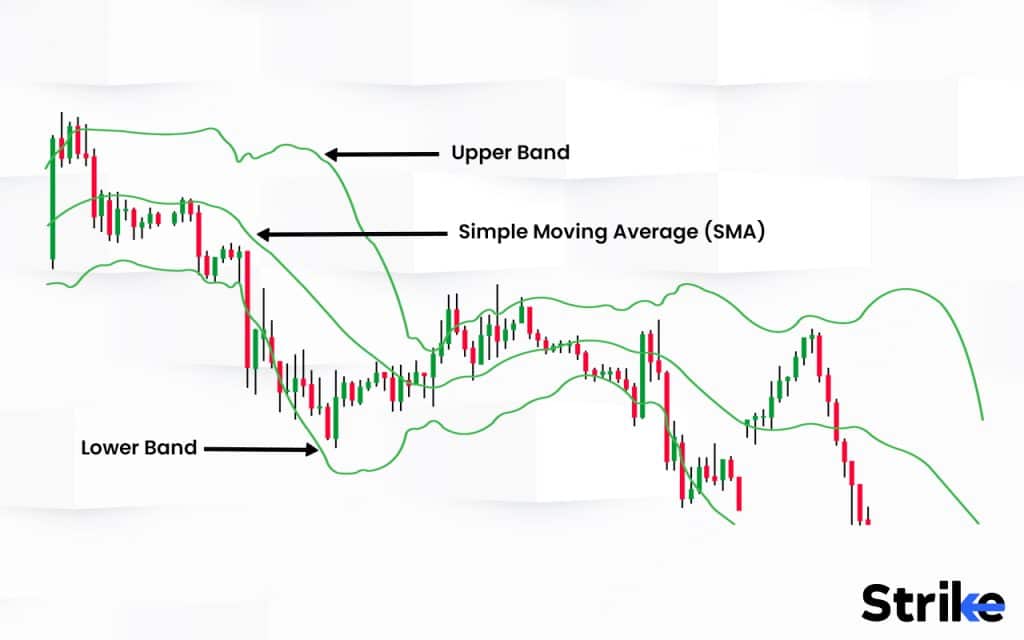
The moving average (MA) is a simple technical analysis tool that smooths out price data by creating a constantly updated average price.
Bollinger Bands are an indicator of market volatility and also measure the relative high or low of a security’s price in relation to previous trades. The bands automatically widen when volatility increases and contract when volatility decreases.
Moving Averages are used to determine support and resistance levels, generate trend-following signals and smooth out price trends by filtering out the noise from random short-term price fluctuations to provide a clearer picture of the overall price trend.
Moving averages and Bollinger Bands have their purposes which complement each other in developing successful trading strategies. Traders combine these tools with indicators and other techniques that act as a comprehensive guide for traders and investors.




![85 Common Stock Market Terminologies for Dummies [Updated List for 2025] 130 85 Common Stock Market Terminologies for Dummies [Updated List for 2025]](https://www.strike.money/wp-content/uploads/2025/04/Popular-Stock-Market-Terms-for-Beginners-Banner.png)










No Comments Yet.